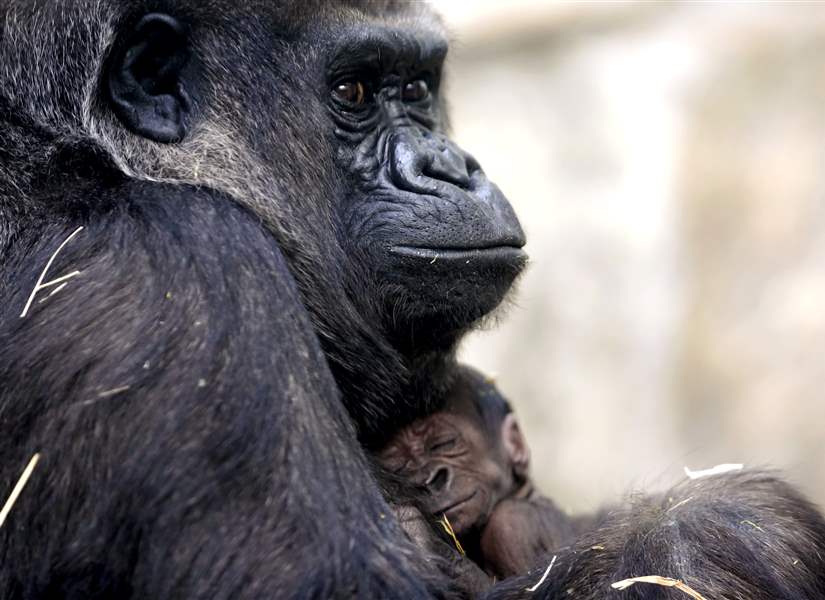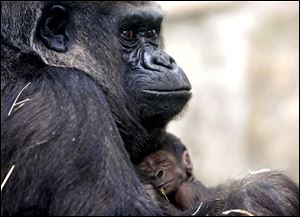
It's a boy! Toledo Zoo announces birth of endangered gorilla
Mokonzi is first gorilla baby since 2003
11/28/2017
Kitani, a western lowland gorilla, holds her 4-day-old baby, Mokonzi, as he naps Tuesday at the Toledo Zoo. He was born overnight after Thanksgiving.
The Blade/Kurt Steiss
Buy This Image
Snuggled tight against his mother’s chest, Mokonzi could easily be mistaken for a human newborn.
The infant western lowland gorilla is the first born at the Toledo Zoo since 2003. He arrived overnight after Thanksgiving, born to 23-year-old Kitani and fathered by the zoo’s silverback male, 29-year-old Kwisha.
Mokonzi, which is Swahili for governor or leader, is Kitani’s third offspring. Her last was born about 15 years ago.
“She remembers what to do,” keeper Mike Payne said. “She’s being a great mom. She’s doing everything just perfectly.”
VIDEO: Toledo Zoo welcomes baby gorilla
The gorilla exhibit in Kingdom of the Apes has been closed since Mokonzi’s arrival, but visitors could see him as soon as Friday if Kitani and the rest of the troop continue to do well.
“They’re protective but also really curious, especially our two youngest females,” Mr. Payne said. “They go up and sit right next to Kitani and they look at the baby and stare and try to sneak in there and touch the baby. Kitani will swat their hands away.”
Nia Lewa, 14, and newer troop member Sufi, 15, have never had babies before. Watching Kitani with Mokonzi will be a valuable learning experience before they become mothers themselves.
“Having the opportunity to have them see the full process of a pregnant mother then giving birth, it won’t be something they're scared of,” said Michael Frushour, associate curator of mammals.
Tuesday morning, Kitani allowed a seemingly enamored Sufi to gently pet Mokonzi’s head for a few brief strokes.
Zoo staff members have not handled Mokonzi, but Mr. Payne said the typical gorilla baby weighs about 4 or 5 pounds. Keepers monitor from afar, ensuring Kitani continues to care for her baby and that Mokonzi is nursing appropriately, has a strong grip to hold onto his mother while she moves about, and is generally thriving.
“We don’t handle the babies at all,” he said. “As long as the mother is taking care of it, we’re hands off.”
Kwisha has been notably protective, planting himself at the glass of the indoor exhibit and displaying related behaviors as he feels necessary. But dad won’t have much to do with Mokonzi — his fifth offspring — until the baby begins leaving his mother’s arms and exploring.

Kitani, a western lowland gorilla, holds her 4-day-old baby, Mokonzi, as he naps Tuesday at the Toledo Zoo. He was born overnight after Thanksgiving.
“In the past, he’s been really playful,” Mr. Payne said of Kwisha. “He’ll pick them up and kind of play with them and tickle them. He’s been a really good dad in the past. But in these early stages, it’s all mom.”
Mr. Frushour said the zoo will control crowds at the exhibit, keeping visitors back from the glass. A volunteer will be on hand to provide information and answer questions.
Mokonzi will likely stay in Toledo for six to eight years, Mr. Payne said. Kwisha will certainly kick his son out of the troop if Mokonzi stays long enough to reach puberty.
“Male gorillas do not tolerate other adult male gorillas anywhere near their females,” he said.
The Toledo Zoo has been very successful in the past with gorilla births. Eleven babies were born between 1987 and 2003, leading the Species Survival Plan that controls breeding in zoos accredited by the Association of Zoos and Aquariums to call a halt.
“In a sense, I think we became a victim of our own success,” Mr. Payne said. “They want to make sure that no particular genes get over-represented in the population. So since we had a lot of babies born, our genes, our gorilla genes, were being over-represented and they told us to stop for a while.”
The pause lasted six or eight years, he said, and the gorillas were slow to get going again. Kwisha generally hadn’t shown much interest in mating, though Kitani likely conceived in early March.
“We don’t know exactly what it may have been that rekindled his interest,” Mr. Frushour said.
The zoo could have another gorilla baby in the not-so-distant future if things go well. Since Sufi arrived in May, Kwisha has been very interested in her and has mated with her frequently, Mr. Frushour said. He has also shown some interest in the other three females, though Sufi is clearly his current favorite.
The females’ urine is regularly tested using human pregnancy tests, and all are trained to allow ultrasounds to monitor a baby’s development. The average gestation for a gorilla is 8½ months.
Western lowland gorillas, which are found in the heavy rainforests of west central Africa, are listed on the International Union for the Conservation of Nature and Natural Resources’ Red List as critically endangered. Their populations are declining primarily due to three interconnected threats of habitat loss, bushmeat hunting, and human encroachment.
Contact Alexandra Mester amester@theblade.com, 419-724-6066, or on Twitter @AlexMesterBlade.